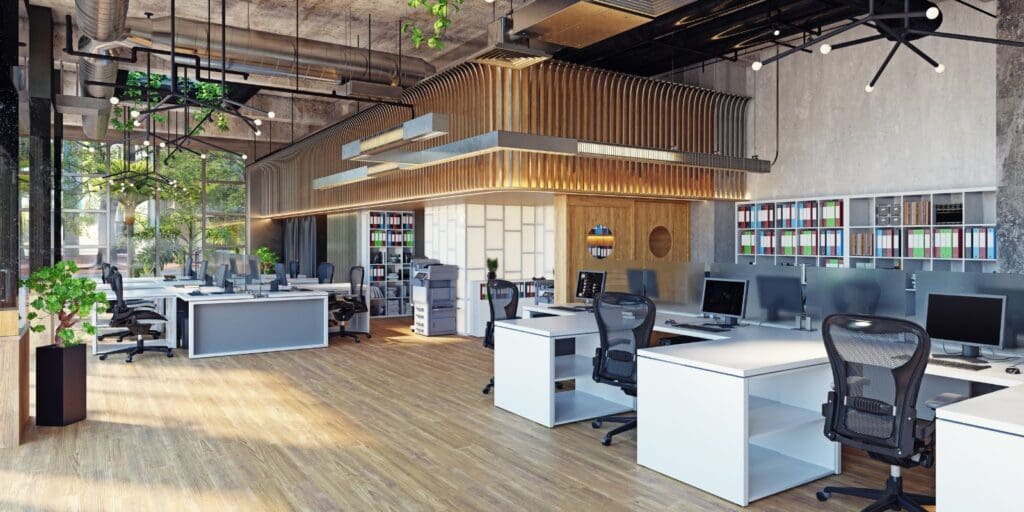The way businesses approach office space has shifted significantly. Companies now seek adaptable environments that support evolving work models, cost-efficiency, and team collaboration. The UK government outlines the benefits of flexible working, highlighting how it enhances productivity, employee well-being, and business efficiency. A flexible workspace provides a tailored solution, allowing businesses to scale operations without long-term lease commitments. Understanding the key factors involved in selecting the right office space ensures companies find a setup that enhances productivity and operational efficiency.
Understanding Flexible Workspaces
A flexible workspace is a dynamic office solution that accommodates various work styles and business needs. These spaces range from serviced offices and coworking spaces to hot desks and private offices. Each type offers unique advantages, from fully furnished setups to shared environments that foster networking opportunities.
A recent report on flexible office spaces in Europe shows a rise in demand for coworking spaces and serviced offices, reflecting the shift toward adaptable work environments.
Industries such as technology, consulting, and creative services often benefit the most from flexible workspaces due to their need for agility. However, even traditional businesses are adopting these models to support hybrid work strategies and reduce overhead costs.
Key Factors to Consider When Choosing a Workspace
Selecting the right office space requires a detailed assessment of several critical aspects:
- Location: Proximity to transport hubs, accessibility for employees, and strategic business positioning all influence workspace selection.
- Cost & Budgeting: Understanding pricing structures, hidden fees, and service inclusions ensures financial sustainability.
- Lease Terms: The ability to scale up or down without long-term obligations is essential for growing businesses.
- Amenities & Services: Meeting rooms, high-speed internet, security, and shared facilities contribute to a productive work environment.
Balancing these elements allows businesses to find a space that meets both immediate and long-term needs. Finding out about options to consider when searching for office rentals can help businesses evaluate office pricing structures and service inclusions more effectively.
The Benefits of a Flexible Workspace
Flexible workspaces offer businesses a scalable, cost-effective alternative to traditional office leases. Whether accommodating hybrid work models or reducing fixed expenses, these solutions provide companies with the agility to adapt to evolving needs.
For businesses looking to maintain productivity while optimising costs, exploring workspace options that allow for easy expansion, built-in amenities, and short-term lease flexibility is essential. Companies can now discover flexible workspace solutions designed to accommodate growing teams, remote work setups, and dynamic business needs, ensuring maximum efficiency without long-term commitments.
By choosing a flexible office solution, businesses benefit from:
- Scalability – The ability to expand or downsize quickly without restrictive leases.
- Cost Savings – Eliminating high upfront investments in furniture, utilities, and maintenance.
- Collaboration & Networking – Access to shared environments that encourage professional connections.
- Hybrid & Remote Work Support – Workspaces equipped with technology and infrastructure for seamless operations.
This adaptability ensures that businesses can focus on growth without the burden of traditional leasing structures.
Comparing Flexible vs. Traditional Office Spaces
Businesses deciding between traditional leases and flexible workspaces should consider the following:
| Factor | Traditional Office | Flexible Workspace |
| Lease Length | Long-term (3-10 years) | Short-term, adaptable |
| Upfront Costs | High (deposit, setup, furniture) | Lower (ready-to-use spaces) |
| Scalability | Limited | Easily adjustable |
| Amenities | Requires separate arrangements | Included in package |
| Collaboration | Private setting | Networking opportunities |
This comparison highlights why many companies are transitioning to flexible workspaces for greater adaptability and cost savings.
Matching Workspace Flexibility with Business Growth
Choosing an office that aligns with business growth requires foresight. Companies should evaluate their expansion potential, team collaboration needs, and cost management strategies when selecting a workspace.
For example, a startup may benefit from a coworking space with networking opportunities, while a scaling SME might require a serviced office with private meeting rooms. Understanding these distinctions ensures that businesses make informed decisions that support operational goals.
Technology and Infrastructure in Flexible Workspaces
Modern workspaces integrate advanced technology to enhance productivity and collaboration. Businesses should assess the following when choosing an office:
- High-speed internet and connectivity for seamless remote and hybrid work.
- Smart office solutions, including automated booking systems for meeting rooms.
- Security features, such as biometric access and cloud-based surveillance.
- Collaboration tools, including video conferencing setups and shared digital workspaces.
Investing in a well-equipped office ensures employees can work efficiently while maintaining a seamless connection with remote teams.
Sustainability in Flexible Workspaces
Many businesses are prioritising eco-friendly office solutions. When choosing a flexible workspace, consider:
- Energy-efficient buildings with sustainable materials and lighting.
- Waste reduction initiatives, such as recycling programs and digital documentation.
- Eco-conscious commuting options, like bike storage and proximity to public transport.
- Green certifications, such as BREEAM or LEED, indicating a commitment to sustainability.
Incorporating sustainability into office choices supports corporate responsibility and enhances brand reputation.
Final Checklist: Is a Flexible Workspace Right for You?
Before committing to a flexible workspace, businesses should assess the following:
✅ Does the location support accessibility and client engagement?
✅ Is the lease structure adaptable to your company’s growth plans?
✅ Are the amenities aligned with your team’s needs?
✅ Does the space foster collaboration or privacy, based on your work style?
✅ Is the technology infrastructure sufficient for remote and hybrid work models?
✅ Does the workspace align with your company’s sustainability goals?
A clear understanding of these factors simplifies the decision-making process and ensures businesses invest in an office that enhances efficiency and productivity.
Conclusion
The shift toward flexible workspaces is more than a trend—it’s a strategic move that helps businesses remain agile, cost-effective, and growth-ready.
By carefully considering location, lease terms, scalability, and team needs, companies can create an optimal work environment that aligns with their operational objectives.

